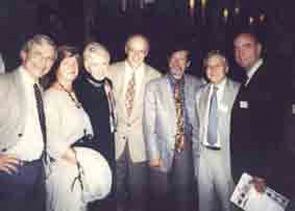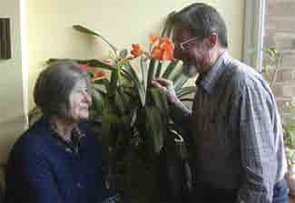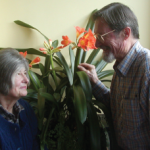Editor’s note: We are sorry to hear that Dr. Paul Bacon, consummate collaborator and pioneering legend of British rheumatology, died peacefully on Jan. 5, 2018. We published this profile in 2010, and are pleased to share it again in his remembrance.
Consummate Collaborator Continues Advances in Measuring Disease Activity
Since 2003, Paul A. Bacon, MD, has been professor emeritus of the University of Birmingham’s Department of Rheumatology (which he founded and has chaired for over 20 years) in the United Kingdom. One look at his current roster of projects, and it becomes clear that “emeritus” simply connotes, for Dr. Bacon, a full plate of investigations, collaborations, and new ventures. The developer of the Birmingham Vasculitis Activity Score (BVAS) has been hard at work on a Takayasu’s arteritis–specific disease index, entailing twice-yearly visits to work with his colleagues in the Indian Rheumatology Association’s Vasculitis Special Interest Group. In between those projects, he continues oversight of the Birmingham Arthritis Resource Centre, chairs the fellowship committee for Arthritis Research U.K., and continues to coauthor a raft of review and clinical investigation papers with his colleagues in the European League Against Rheumatism Systemic Vasculitis Task Force, among others. Now add to these enterprises a lively family life (eight grandchildren) and trying, he says, “to run a large garden and get it under proper control,” and it’s easy to see why his wife wonders when his retirement will start.

During several telephone conversations, Dr. Bacon admitted he’s swimming in projects. “But the problem is,” he said good-humoredly, “I’m always enlarging them into new ones! One of my previous secretaries said to me, ‘You must learn to say no,’ but it does spoil life.” Former trainee David G.I. Scott, MD, of the Department of Rheumatology at Norfolk and Norwich University Hospital in Norwich, U.K., notes that his long-time collaborator and friend “has almost done more successful research post-retirement, since he is now free of the huge amount of administrative work that comes with chairing and running a department.”
A “Can-Do” Attitude
An unremitting scientific curiosity and a zest for collaborations have characterized Dr. Bacon’s career. He spoke of his diverse educational experiences and the opportunities he’s had to become one of rheumatology’s premier clinical investigators.
Choosing medicine meant that Dr. Bacon became “the black sheep of the family,” he jokingly remarked, because he broke with family tradition to do so (both his grandfather and father were actuaries). Encouraged by “an extremely good biology master” at his Quaker school, the young Dr. Bacon sat for the Cambridge entrance exams, was accepted, and then did his clinical studies at the “ancient” hospital of St. Bartholomew, founded in 1123.
As a resident in general internal medicine/ cardiology, he worked with a group that had introduced cardiac catheterization to the U.K. Serendipitously, the junior physician in that group had an interest in rheumatology. Early in his residency, Dr. Bacon received a double exposure to both research (he collaborated with his senior attending on investigations into subacute bacterial endocarditis) and to the value of measurement in disease. His cardiology colleagues’ precise measurements of their patients’ cardiac output and of their catheterization procedures piqued Dr. Bacon’s interest, especially because rheumatology lacked those tools in the mid 1960s.
From 1965 to 1968, Dr. Bacon was a research fellow/registrar at the newly established Kennedy Institute of Rheumatology in London. He then received an Arthritis Research Campaign (ARC) Copeman Traveling Fellowship to spend a year with Carl Pearson, MD’s rheumatology group at the University of California, Los Angeles (UCLA). Again, the measurement theme resonated with Dr. Bacon, who spent time with Dr. Pearson on the other end of a two-headed microscope, while the senior physician scored pathology in animal arthritis. The other key lesson Dr. Bacon took from his UCLA experience, he recalls, was a “can-do attitude—that things can be done. And I’m eternally grateful to America for giving me that,” he says.

From Bath to Birmingham
The can-do attitude served Dr. Bacon well when he returned to England to become a consultant rheumatologist at the Royal National Hospital for Rheumatic Diseases in Bath. Despite its long tradition with the rheumatic diseases (the hot mineral springs were the birthplace of the hospital in 1750), there was “virtually no scientific research (and no immunology)” emanating from there at the time, Dr. Bacon says. He promptly set up a lab in the hospital basement and began to recruit research fellows. One of those people was Dr. Scott, who thought that rheumatology was going to be more of a quiet specialty. Instead, he recalls, “Dr. Bacon ran me ’round the hospital—I didn’t stop running for four years!” Dr. Bacon began work in earnest on vasculitis and lupus, collecting, with Dr. Scott, 80 cases of vasculitis over a nine-year period. The two also set up a vasculitis and lupus clinic at Southmead Hospital in Bristol, publishing one of the first series of mixed systemic vasculitis. “I’m very proud of that one,” says Dr. Bacon.
His nine years in Bath were “a tremendous experience,” Dr. Bacon says. With exposure to a range of rheumatic disease, he says, “I was learning all the time.” By 1981, he had established himself as a leading immunology researcher, which led to his appointment as the ARC’s foundation chair in rheumatology at Birmingham, U.K.
The ARC was funding the setup of a rheumatology service because a survey revealed a paucity of rheumatology services for the West Midlands region, which had a population of 6 million and no full-time rheumatologist. There are now more than 30 full-time rheumatologists in the region. The situation in Birmingham was daunting. “In essence,” recalls Dr. Bacon, “it was a blank slate.” Dr. Bacon says that another physician told him he’d have to give up his interest in vasculitis because “we never see that in Birmingham.” That soon changed, as Dr. Bacon and his team set up connective tissue disease clinics specifically for vasculitis and lupus within the university. Dr. Scott worked with Dr. Bacon between 1977 and 1988, following him to Birmingham to help set up the rheumatology unit. What has always impressed Dr. Scott is Dr. Bacon’s enthusiasm. “It gets to you,” he says. “You do things that you would normally have said no to, and you end up saying yes to him, which is very annoying!”
In addition to the BVAS, Birmingham—and specifically, Dr. Bacon’s garden—became the birthplace of the British Isles Lupus Assessment Group, which two years ago again met in his garden to celebrate its 25th anniversary.

BVAS and Beyond
Loïc Guillevin, MD, PhD, of the department of internal medicine at Hôpital Cochin at the Université Paris Descartes, France, first met Dr. Bacon at an ACR meeting more than 20 years ago. Sharing an interest in the vasculidities and agreement on treatments of pulse cyclophosphamide for polyarteritis nodosa, the two began collaborating very quickly, says Dr. Guillevin.
Dr. Bacon was a key player in the third wave of vasculitis, which exploded following the discovery of the diagnostic possibilities of antineutrophil cytoplasm antibody (ANCA), says Wolfgang L. Gross, MD, PhD, medical director and chair of the department of rheumatology and immunology at the University of Lübeck, Bad Bramstedt, in Lübeck, Germany. “The second wave—people like Anthony Fauci—had new therapeutic approaches, but the third-wave group—people like Paul Bacon—began to realize that we needed instruments to measure outcomes for randomized, controlled trials.”
Gene G. Hunder, MD, professor emeritus of the Mayo Clinic in Rochester, Minn., has also shared a lifelong interest in the vasculidities. “The vascular inflammatory diseases were always thought to be uncommon, and studies on them languished,” he notes. Dr. Bacon’s work in developing a disease activity index contributed to advances in treatments, since the indices made possible the comparison of outcomes using common criteria.
What had originally sparked Dr. Bacon’s interest in developing a vasculitis index was not just the number of cases he and his recruits saw in their clinics. Discussion with his nephrology colleagues, who were also seeing disease, made him question their assumption that the kidney was the most important organ to assess. He and Raashid Luqmani, DM, a consultant rheumatologist at the University of Oxford in Oxford, U.K., and another leading figure in vasculitis research, compared disease severity in patients presenting with airways vasculitis with a group presenting with renal vasculitis, and found that the morbidity and mortality were similar. After those findings, he and Dr. Luqmani assembled a study group and persuaded the nephrologists to collaborate to develop a disease activity index that scores organ involvement in a total of 10 categories.
First published in 1994, the BVAS attracted the attention of European researchers, who were looking for an index to measure disease activity in order to compare outcomes in clinical vasculitis trials.1 Although he characterized the initial creation of BVAS, in concert with nephrologists, as “one of the most difficult things I’ve ever done,” Dr. Bacon was also challenged by the European Vasculitis Study Group to refine and improve the definitions to better serve the group and its studies. Further work by his colleagues in Paris (including Dr. Guillevin) showed that using the BVAS to assess patients at presentation could also predict prognosis and mortality.
“In this phase of the ‘third wave,’ Dr. Bacon, together with Raashid Luqmani, was very productive,” says Dr. Gross. “Dr. Bacon is a very impressive person. Always, in discussion, he was a really keen thinker and he made very clear statements.”
Dr. Guillevin agrees, saying “[Dr. Bacon] is a very good chairman because his questions are very useful and stimulating. He was also one of the first people to think of [the association] of arteriosclerosis in vasculitis. He is like a machine, making new projects and new ideas all the time.”
CAREER TIMELINE
1966–Becomes research fellow and registrar at Kennedy Institute of Rheumatology
1969–Becomes senior registrar at St. Bartholomew’s Hospital
1971–Becomes research fellow in rheumatology at UCLA
1972–Becomes consultant rheumatologist at Royal National Hospital for Rheumatic Diseases in Bath and Southmead Hospital in Bristol
1981–Becomes ARC chair and head of rheumatology at the University of Birmingham
1988–Completes sabbatical year at the NIH
2001–Becomes professor of rheumatology at the University of Birmingham
Collaborations Make It Interesting
Referring to his diverse background, Dr. Bacon remarks, “You see, I’m a bit of mixed-up kid.” But it was this varied background, he believes, that has allowed him to accomplish productive collaborations across disciplines and across continents. “Without collaborations,” he notes, “you cannot move forward in these rare diseases, because you need different sorts of expertise coming into it.”
His current major project, bringing to completion a disease activity index for Takayasu’s arteritis, has been taking him to India each year. The disease is much more common in Asia. “We saw one or two cases of Takayasu’s a year in our vasculitis clinic in Birmingham. In the referral center in Vellore, South India, they have 170-plus cases,” he says. Dr. Bacon has been instrumental in fostering investigator-driven studies, says Rohini Handa, MD, senior consultant rheumatologist for Indraprastha Apollo Hospitals in New Delhi, India, and current president of the Indian Rheumatology Association. “Paul is willing to act as a catalyst and then steps back to let others occupy center stage. He has this ability to bring out these strengths in individuals who might otherwise have been reticent to contribute, and use those strengths in connecting the group.”
Dr. Hunder agrees. In his dealings with Dr. Bacon, he has always noticed that “he takes a scientific approach, has a practical attitude, and shares any results with others [who] have helped to make progress in his work. He is a very friendly, outgoing, and open person, and has a great attitude.”
The development of the Indian Takayasu Activity Score “is almost like a mission for him,” marvels Dr. Handa. “He’s been like a man possessed. When the team slows down, he does not let the group lose focus.” The score is in the final stages of validation and will then be submitted for publication.
In the meantime, when Dr. Bacon is at home in Birmingham, he is still active as chair of the Birmingham Arthritis Resource Centre, which emanated from a needs assessment conducted in 2000 revealing that immigrant and minority patients with rheumatoid conditions were being underserved. The center provides educational material and support to the city’s ethnic populations, which have poor access to standard National Health Service medical services, he says. Echoing the results of two recent national surveys, Dr. Bacon says, “treatment of arthritis isn’t just [giving] drugs for the disease—it requires social support and education, all the things we’re trying to do.”
An endless curiosity has made Dr. Bacon one of rheumatology’s foremost promoters of collaborative, investigator-driven efforts. “He’s not an archetypical Brit,” quips Dr. Scott. “You know, they are supposed to sit, moan and complain, and find reasons not to do things. He’s either got an Australian or an American approach, because he’s very much a can-do person.”
The indefatigable Dr. Bacon seems to fully relish each of his current passions. During his time off, he and his wife like to “escape to France and go wine tasting and hill walking,” he says. At home, there is the garden with its endless particularities and delights. “I have planted some camellias in my front garden, and I think, at last, have found a place with sufficient shelter for them to grow,” he says. And in part of that garden, in memory of his former biology teacher, to whom he “owes a great deal,” he has planted some old fashioned cottage garden roses.
Gretchen Henkel is writing the “Metrics in Rheumatology” series.


